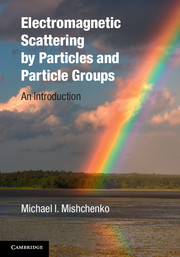Book contents
- Frontmatter
- Dedication
- Contents
- Preface
- Acknowledgments
- Acronyms
- 1 Introduction
- 2 The macroscopic Maxwell equations and monochromatic fields
- 3 Fundamental homogeneous-medium solutions of the macroscopic Maxwell equations
- 4 Basic theory of frequency-domain electromagnetic scattering by a fixed finite object
- 5 Far-field scattering
- 6 The Foldy equations
- 7 The Stokes parameters
- 8 Poynting–Stokes tensor
- 9 Polychromatic electromagnetic fields
- 10 Polychromatic scattering by fixed and randomly changing objects
- 11 Measurement of electromagnetic energy flow
- 12 Measurement of the Stokes parameters
- 13 Description of far-field scattering in terms of actual optical observables
- 14 Electromagnetic scattering by a small random group of sparsely distributed particles
- 15 Statistically isotropic and mirror-symmetric random particles
- 16 Numerical computations and laboratory measurements of electromagnetic scattering
- 17 Far-field observables: qualitative and quantitative traits
- 18 Electromagnetic scattering by discrete random media: far field
- 19 Near-field scattering by a sparse discrete random medium: microphysical radiative transfer theory
- 20 Radiative transfer in plane-parallel particulate media
- 21 Weak localization
- 22 Epilogue
- Appendix A Dyads and dyadics
- Appendix B Free-space dyadic Green's function
- Appendix C Euler rotation angles
- Appendix D Spherical-wave decomposition of a plane wave in the far zone
- Appendix E Integration quadrature formulas
- Appendix F Wigner d-functions
- Appendix G Stationary phase evaluation of a double integral
- Appendix H Hints and answers to selected problems
- References
- Index
- Plate Section
17 - Far-field observables: qualitative and quantitative traits
Published online by Cambridge University Press: 05 July 2014
- Frontmatter
- Dedication
- Contents
- Preface
- Acknowledgments
- Acronyms
- 1 Introduction
- 2 The macroscopic Maxwell equations and monochromatic fields
- 3 Fundamental homogeneous-medium solutions of the macroscopic Maxwell equations
- 4 Basic theory of frequency-domain electromagnetic scattering by a fixed finite object
- 5 Far-field scattering
- 6 The Foldy equations
- 7 The Stokes parameters
- 8 Poynting–Stokes tensor
- 9 Polychromatic electromagnetic fields
- 10 Polychromatic scattering by fixed and randomly changing objects
- 11 Measurement of electromagnetic energy flow
- 12 Measurement of the Stokes parameters
- 13 Description of far-field scattering in terms of actual optical observables
- 14 Electromagnetic scattering by a small random group of sparsely distributed particles
- 15 Statistically isotropic and mirror-symmetric random particles
- 16 Numerical computations and laboratory measurements of electromagnetic scattering
- 17 Far-field observables: qualitative and quantitative traits
- 18 Electromagnetic scattering by discrete random media: far field
- 19 Near-field scattering by a sparse discrete random medium: microphysical radiative transfer theory
- 20 Radiative transfer in plane-parallel particulate media
- 21 Weak localization
- 22 Epilogue
- Appendix A Dyads and dyadics
- Appendix B Free-space dyadic Green's function
- Appendix C Euler rotation angles
- Appendix D Spherical-wave decomposition of a plane wave in the far zone
- Appendix E Integration quadrature formulas
- Appendix F Wigner d-functions
- Appendix G Stationary phase evaluation of a double integral
- Appendix H Hints and answers to selected problems
- References
- Index
- Plate Section
Summary
In Chapters 13 and 15 we have introduced a number of important far-field characteristics and discussed their general mathematical properties. In Chapter 14, we have seen that the same quantities enter the FOSA for a small group of randomly and sparsely distributed particles observed from a sufficiently remote location. In Chapter 19, we will see that the same far-field characteristics enter the RTE for a very large random group of sparsely distributed particles observed from a point located in the near zone of the group. Given the ubiquity and great practical importance of these quantities, it would be essential to discuss their typical qualitative and quantitative traits. We will do this mostly with the help of the numerically exact LMT, TMM, and STMM described in the preceding chapter.
We have seen in Chapter 14 that, in the framework of the FOSA, the actual particles forming a random N-particle group are effectively replaced by N statistically identical copies of the virtual FOSA particle. We will see later that the same happens in the RTT. As a consequence, the far-field characteristics serve a triple purpose of representing: (i) the whole object in the framework of the FFS formalism, (ii) the virtual FOSA particle, and (iii) the virtual RTT particle. In this chapter we will not make a distinction between these three scenarios and will use the term “particle” in application to the whole FFS object, the virtual FOSA particle, or the virtual RTT particle.
- Type
- Chapter
- Information
- Electromagnetic Scattering by Particles and Particle GroupsAn Introduction, pp. 238 - 269Publisher: Cambridge University PressPrint publication year: 2014



